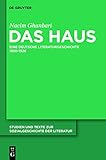Das Haus : Eine deutsche Literaturgeschichte 1850-1926 / Nacim Ghanbari.
Material type: TextSeries: Studien und Texte zur Sozialgeschichte der Literatur ; 128Publisher: Berlin ; Boston : De Gruyter, [2011]Copyright date: ©2011Description: 1 online resource (160 p.)Content type:
TextSeries: Studien und Texte zur Sozialgeschichte der Literatur ; 128Publisher: Berlin ; Boston : De Gruyter, [2011]Copyright date: ©2011Description: 1 online resource (160 p.)Content type: - 9783110237993
- 9783110238006
- Families in literature
- Genealogy in literature -- 19th century -- History and criticism
- Genealogy in literature
- German literature -- 19th century -- History and criticism
- German literature -- 20th century -- History and criticism
- Dynastie
- Familienroman
- Literatur der Moderne
- LITERARY CRITICISM / European / German
- Dynasty
- Family Saga
- Literature in the Modern Age
- 830.9/008 23
- PT345 .G48 2011eb
- online - DeGruyter
- Issued also in print.
| Item type | Current library | Call number | URL | Status | Notes | Barcode | |
|---|---|---|---|---|---|---|---|
 eBook
eBook
|
Biblioteca "Angelicum" Pont. Univ. S.Tommaso d'Aquino Nuvola online | online - DeGruyter (Browse shelf(Opens below)) | Online access | Not for loan (Accesso limitato) | Accesso per gli utenti autorizzati / Access for authorized users | (dgr)9783110238006 |
Dissertation Universität Konstanz 2008.
Frontmatter -- Vorbemerkung -- Inhalt -- Einleitung -- Kapitel I. Das Haus -- Kapitel II. Adoptieren -- Kapitel III. Ehen stiften -- Kapitel IV. Schenken -- Schluss -- Siglenverzeichnis -- Literaturverzeichnis
restricted access online access with authorization star
http://purl.org/coar/access_right/c_16ec
How is the continuity of family enterprises and of aristocratic and bourgeois dynasties ensured? This is the question given close attention in German-language novels at the end of the 19th century in their creation of various genealogical narrative patterns – beginning with Gustav Freytag and continued by Theodor Fontane and later by Ricarda Huch and Franz Kafka. This study reconstructs these narrative patterns by invoking the socio-anthropological category of the “house”. Here, the house is an institution which is able to create and define its own rules in order to secure its continuity.
Wie lässt sich Kontinuität von Familienunternehmen sowie von adligen und bürgerlichen Dynastien herstellen? Das ist die Frage, mit der sich deutschsprachige Romane Ende des 19. Jahrhunderts intensiv beschäftigen, wenn sie verschiedene genealogische Erzählmuster entwerfen – angefangen bei Gustav Freytag über Theodor Fontane bis Ricarda Huch und Franz Kafka. Die vorliegende Studie rekonstruiert diese Erzählmuster, indem sie die sozialanthropologische Kategorie des „Hauses“ ins Feld führt. Das Haus ist hier eine Institution, welche die Regeln zu ihrer Kontinuitätssicherung selbst aufzustellen und zu definieren vermag.
Issued also in print.
Mode of access: Internet via World Wide Web.
In German.
Description based on online resource; title from PDF title page (publisher's Web site, viewed 28. Feb 2023)


